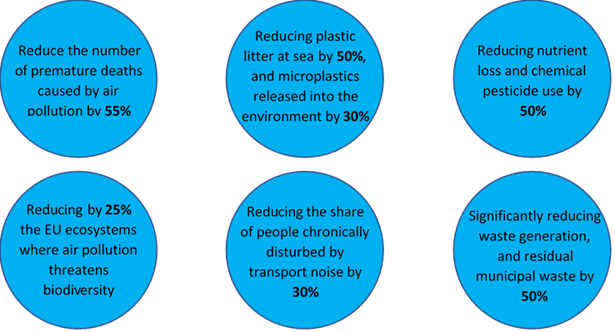The focus of this year’s upcoming EU Green Week (31 May – 4 June) is on zero pollution, and will present an opportunity to engage the public and stakeholders in the European Union’s Zero Pollution Ambition. The EU’s recently adopted Zero Pollution Action Plan (ZPAP) establishes the framework and guiding principles that will underpin the delivery of this ambition, and with Green Week approaching, it is worth reviewing the approach and new direction set out in the Action Plan.
Announced in December 2019, the European Green Deal consists of a package of interrelated initiatives aimed at achieving carbon neutrality by 2050 and decoupling continued economic growth from environmental degradation. This will be primarily delivered through a Chemicals Strategy for Sustainability, adopted in 2020, the aforementioned ZPAP, adopted 12 May 2021, and a suite of revisions to measures addressing pollution from large industrial installations, including amendments to the Industrial Emissions Directive and E-PRTR Regulation (the Logika Group are supporting the European Commission with the revision of the latter).
The ZPAP sets as its overarching vision the reduction of air, water and soil pollution to levels that do not pose a risk of harm to human health and natural ecosystems. Clearly, this is an objective spanning different environmental topic areas and crucially the Plan states that “we need a better integrated overview of pollution for public and private actors to tackle connected pollution issues across space and time and address their interplay with other environmental, social and economic considerations as effectively in their policy, investment and purchase decisions”. As such, the ZPAP is consistent with the integrated and transformative scope of the European Green Deal, which seeks to facilitate a transition to greener business and industry.
Historically, environmental policy-making has been grounded in recurring precepts, namely the precautionary principle (taking preventative action to counter environmental risks), polluter pays (for any environmental damage they cause) and the principle of source reduction measures to prevent pollution formation / release in the first place.
These pillars constitute the architecture of the new ZPAP. However, in the transformative spirit of the European Green Deal, the Plan incorporates these principles into a reversed hierarchy of action on pollution (i.e. prevent by better design and production > minimise and control > eliminate and remediate). In the past, environmental policy and action planning has often taken a reactive stance to respond to pollution and environmental degradation. By contrast, the ZPAP seeks to prevent pollution in the first instance through new design and production practices, minimising pollution where it arises, and implementing effective minimisation and remediation only where pollution is inevitable. Not only is the purpose of the hierarchy to deliver improvements to the environment, but also to foster innovation and business and industrial transition to green opportunities. Elsewhere, this is reflected in the European Industrial Strategy, which aims to accelerate the ‘twin transition’ to a green and digital economy.
The ZPAP sets a number of targets to be achieved by 2030 including the following:

In addition, the ZPAP places greater emphasis on emerging issues of environmental concern; topics where significant uncertainty around the impacts and scale of the issue persists. This includes actions to tackle microplastic releases to the environment and micropollutants such as pharmaceuticals and persistent organic pollutants (POPs) (both areas where the Logika Group are currently supporting the European Commission). The Plan identifies price instruments as a means to encourage uptake of less polluting products and processes in industry and to internalise the costs of pollution to the polluters. Options highlighted to achieve this includes incentivisation of clean alternatives and application of extended producer responsibility schemes.
So how ambitious is the plan? Whilst there are a number of headline targets across a range of areas, some of these are already enshrined in existing EU legislation in each thematic area e.g. the target to reduce health impacts of air pollution are based on full implementation of the National emissions Reduction Commitments Directive (NECD). As a result, the EEB was less than impressed and stated that it “falls short on ramping up action to prevent pollution at source and instead mainly lists existing legal obligations and ongoing reviews”. Other stakeholders have mixed views. Only time will tell how ambitious the plan really is. In particular, there are some areas covered by the plan where there are legislative gaps at an EU level (e.g. on soil and microplastics) so future actions could have real impacts on driving improvements in those areas.
The Logika Group has extensive experience of supporting the European Commission, national governments, NGOs and industry with the development, implementation and evaluation of environmental policies, including a number of areas of relevance to the Green Deal and ZPAP.
To find out more, please get in touch: BenGrebot@logikagroup.com.
View all news